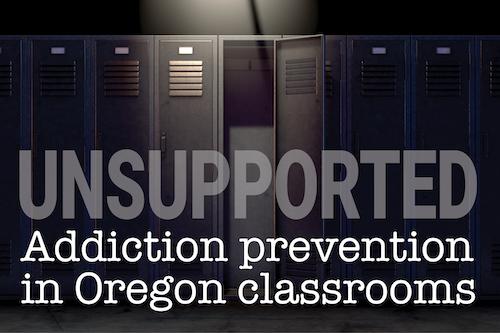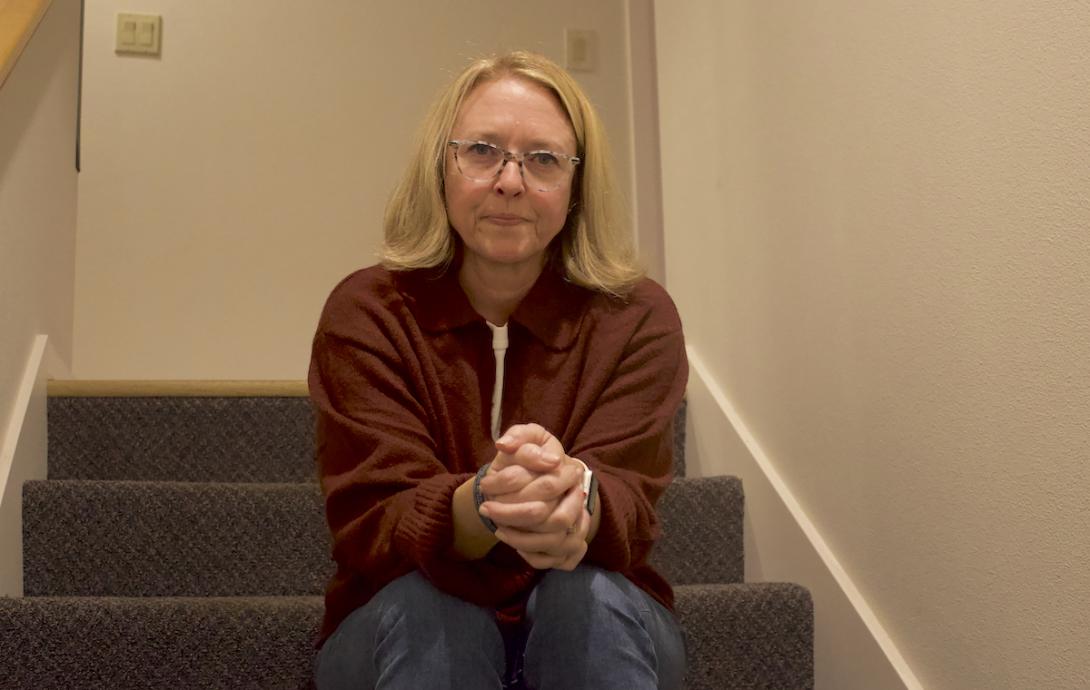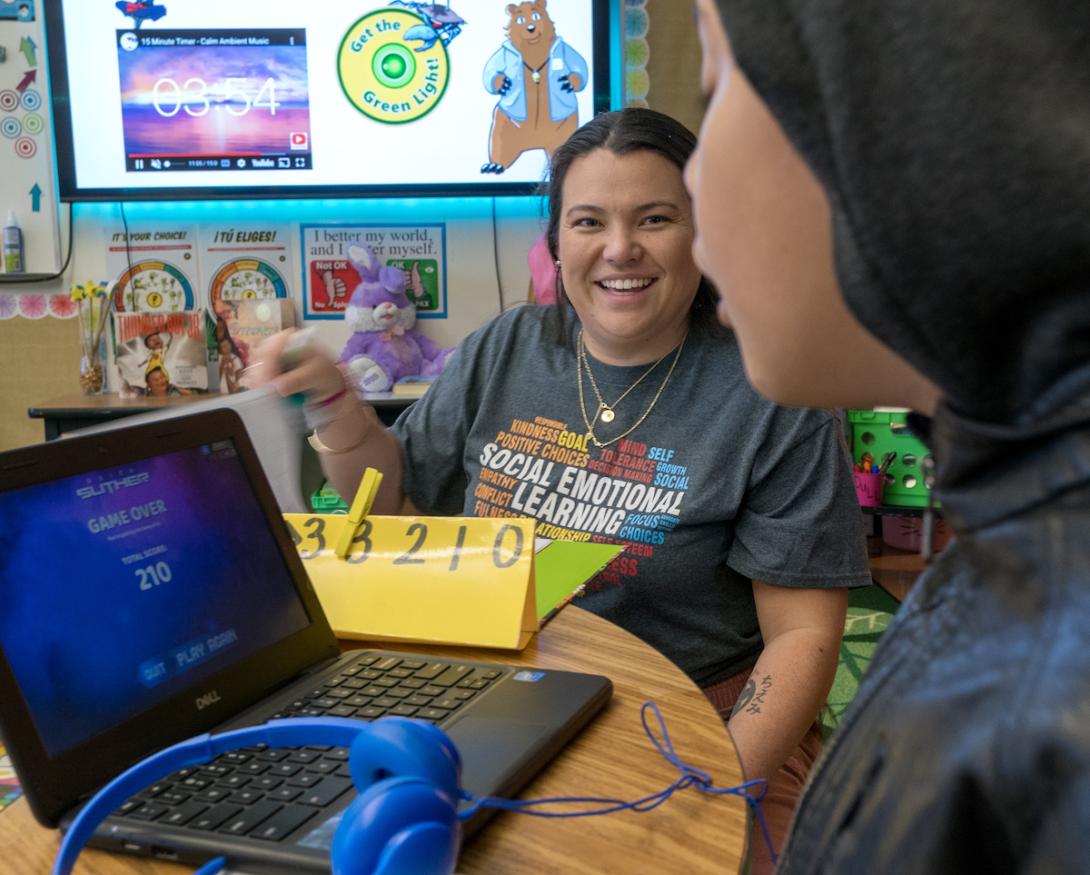
Holly Pearce, 18, tables with a strategy at the West Linn High School club fair. If prospective members join her in-school club, she tells them, they can do little more than show up while receiving free food and an honors cord for their gown at graduation.

This article is part of an investigative series showing that as Oregon kids face a world with increasingly dangerous drugs and unparalleled external pressures, the state’s education establishment has failed to adapt.
What she doesn’t lead with is that it’s a drug and alcohol prevention club.
“The free food,” she said “that’s what gets people there in the first place.”
Once students are in the door, she said, it’s her mom who gets them to stay.
Pam Pearce has been in recovery for 28 years. During lunchtime club meetings, she often shares her personal story with club members, she said, and she tells it to them straight.
She grew up nearby in Lake Oswego and attended the University of Southern California. The photos she displays of smiling youths from her high school and college years look much like the club members she shares the photos with.
“The only honors I had was biggest partier and best dressed,” she said. “And I like to say it because the end of the story is: that almost killed me.”

The point is to dispel the myth that addiction only affects “other” people. It can be anyone, she said, and it can be the teens in the club or one of their friends.
A concerned parent pushing for prevention, Pearce is part of an emerging trend in Oregon, where, according to federal data, at least 354 youths have died from drug overdoses since the start of 2018 as fentanyl has spread through the drug supply.
Oregon schools enjoy wide autonomy in what they teach, and that includes their substance use prevention strategies. A recent six-month investigation into prevention in Oregon classrooms from The Lund Report found that many schools rely on little more than a chapter in a health textbook to get the job of prevention done.
The state provides little support or accountability when it comes to in-school prevention, records and interviews show. So in districts where more robust prevention is happening, it’s often parents and individual teachers who drive it.
In Oregon City, Michele Stroh began pushing for prevention after she lost her son, Keaton Stroh, 25, to a fentanyl-laced pill in July 2020.
“I didn’t know about fake pills; I didn’t know about any of that. And I got angry,” Stroh said. “So I ran for the Oregon City School Board.”
She wanted the district to be more proactive in the fentanyl crisis, she said. So she recruited speakers to talk at assemblies at all the Oregon City School District high schools, middle schools and charter schools. She organized a parent education night, and her efforts resulted in the overdose reversing drug Narcan being placed in all the schools, sports facilities and school buses.
“We were the first school district in Clackamas County to have a Narcan policy,” she said.
She’s approached other districts but found them to be more hesitant.
“I think it helps, the fact that the district knows me, and the teachers know me — and they knew my son,” Stroh said.
Jon and Jennifer Epstein were also pushed into action after losing their son Cal Epstein, 18, to a fentanyl-laced counterfeit pill in December 2020. They began advocating for fentanyl education and awareness in the Beaverton School District, where their sons attended school and Jon Epstein had taught for 10 years. The district worked with them to create a program called “Fake and Fatal,” which teaches youths about the dangers of fentanyl and counterfeit pills. Since then, at the Epsteins’ urging, Oregon legislators passed a bill to take fentanyl education statewide, and Oregon’s congressional delegation has introduced national legislation.

While some parents, such as Pearce in West Linn, had to investigate to figure out what prevention is happening at their kids’ schools, The Lund Report created a data portal that makes that information easily accessible for the first time — including what top prevention scientists say about the efficacy of programs in use at each district.
Pearce’s club at West Linn High School has grown to nearly 200 student members. The teens also advise their community prevention coalition, which Pearce — known for her advocacy — was recruited to lead. And they visit middle schools to talk to younger kids about what to expect in high school.
What teens say
The Lund Report recently sat down with some teenagers who participate in the prevention club. They said the club creates a safe space where kids can talk honestly about drugs — or go to when they don’t want to be around teens who are using.
“My view immediately changed as I set foot in this club,” said the club’s president, Jonathan Garcia, 17. “I listened to Pam in that first meeting, and I was just like, ‘Oh, my God — what have I been taught?’ It was like, number one, I haven't been taught anything compared to what I just learned, and I’ve been taught all the wrong things.”
The club discusses topics like why a person might turn to drugs and alcohol in the first place. Some of the teens said it was the first time they learned about addiction’s root causes.
“Nothing was sugar coated,” said Aidan Sauer, 15. “Everything was just to the point.”
Growing the club at her daughter’s high school is just one way Pearce promotes prevention in the West Linn-Wilsonville school district, where all three of her kids were students.

She sends teachers information about prevention-related tools and lessons. And she lobbied her district until it agreed to participate in the state’s Student Health Survey. The survey asks students in the sixth, eighth and 11th grades about their substance use and well-being. Pearce said she “was on a mission” after she found out her local district didn’t administer the free survey.
“It also allows young people to share with you what’s happening in their environment. Like — how else are they going to tell you what's happening?” she said.
Starting this year, every Oregon school is required to take part in the survey for the first time. Prevention scientists say the data can help districts to understand whether or not their prevention efforts are working. Many prevention programs, including clubs like the one at West Linn High School, aren’t well-researched. Others might not work in every setting and for every group of kids, so tracking the outcomes is important, experts say.
In 2020, Pearce also co-founded the first high school in Oregon for students in recovery from addiction, located in Lake Oswego.
Teaching kids self-regulation in Washington County
A prevention program called the PAX Good Behavior Game doesn’t teach kids anything about drugs and alcohol, but prevention scientists at Oregon Research Institute and Washington State University’s IMPACT Research lab contend it’s one of the best evidence-backed approaches to substance use prevention at the elementary school level.
Today, the program is in wide use across Washington County, and its successful implementation there can be traced to the efforts of a former third grade teacher at Joseph Gale Elementary School and a concerned mother who happens to work for the county.

On a foggy morning this past November, third graders in a second-floor classroom at Fern Hill Elementary in Forest Grove focused intently — and quietly — on their arithmetic. With a handful of unfamiliar adults watching the lesson, there were plenty of distractions that day. But the 8- and 9-year olds seemed un-bothered as they completed math problems on their Chromebooks.
Helping them focus was the PAX Good Behavior Game, also known as PAX. It’s a program that gives teachers a menu of techniques for helping kids self-regulate and practice self control.
At the core of the system is a game, and in some studies, playing that game in elementary school reduced substance use and other problems among students years later.
The teacher sets a length of time the game will be played, and if kids are able to stay on task, they’re rewarded a goofy dance or some other non-material prize when the time is up. While the clock was ticking, third grade teacher Kayla Davidson walked around the classroom observing the students work. If someone got up or lost focus, she would give their table — not the individual student — what’s called a “spleem,” which is basically a negative point. At the end of the game, tables had the opportunity to explain collectively how they might avoid getting a spleem next time.

Before PAX, Davidson said she was more reactive in her approach to disruptive behavior. She might call a student’s parent or call out a child for their behavior in front of the class. “That could really be hurtful and harmful to the student, if they're just being called out for bad behavior constantly,” she said.
“A lot of them are bringing things with them. It could be things like hunger or worrying about which parent they’re going with today,” Davidson said. The game gives the kids “a space and a strategy” for not having to worry about those things so they can focus on their work, she added.
Third graders in Davidson’s classroom told The Lund Report that, for the most part, they really like playing the game. For 8-year-old Aubrey Stone, “the best part about it is that you’re growing your brain.”
About 13 years ago, Kirstina Meinecke brought PAX to the Forest Grove School District when she got a job as a third grade teacher there. She had learned how to use the game when teaching in Washington on the Yakima Indian Reservation. Other teachers took interest, and it began to spread. Today, PAX is incorporated into every elementary school classroom in the Forest Grove district, and into teachers’ ways of conducting their classrooms. Meinecke’s job with the district now is primarily to provide teachers with PAX training and ongoing support as a coach.

Forest Grove is one of four districts in Washington County that uses the PAX Good Behavior Game. While PAX was spreading there, a public health program supervisor at Washington County, Rebecca Collett, started working to spread the program into other county schools. She’d noticed a need for better classroom management while volunteering at her son’s school in the Tigard-Tualatin district.
Collett remembers asking, “Why are we doing so many programs, when there’s one evidence-based program that prevents suicide, prevents drug and alcohol use, prevents dysregulation in the classroom, prevents all this?”
Since then, the county has helped school districts fund the implementation of the PAX Good Behavior Game through a mix of county, state and federal funds. The county has trained nearly 800 teachers at 51 schools on how to use PAX since 2014.
“Once it started working, we didn’t have to sell it,” Collett said. “The teachers started sharing how well it was working in their classroom, how much healthier they were, how much easier classroom behaviors were, and management.”
The county estimated it saves $83 for every $1 spent, and the cost is about $13 per student.
Tools for parents
Pearce encourages other concerned parents to take action if they want to see better prevention programs in their kids’ schools.
“People talk, but they don’t act,” she said. “We need to stop talking, and we need to start doing.”
She said parents should start by reaching out to their county health departments to see if there is a local prevention specialist or prevention coalition they can connect with, and they should attend school board meetings, ask questions and advocate. They can even start a club like the one she leads, she said.
Parents also can share evidence-based practices and materials with their districts and teachers they know, she added.
Figuring out what prevention programs are supported by validated research can be tricky, but there are several online registries that parents and community groups can use to learn more about programs. The online database published by The Lund Report used expert ratings from these clearinghouses to rate districts’ programs.